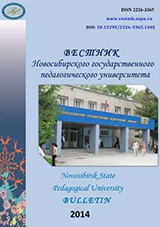ПЕДАГОГИЧЕСКОЕ СОПРОВОЖДЕНИЕ – ВИД ВЗАИМОДЕЙСТВИЯ В ДЕЯТЕЛЬНОСТИ СРЕДНИХ ПРОФЕССИОНАЛЬНЫХ ОБРАЗОВАТЕЛЬНЫХ ОРГАНИЗАЦИЙ
PEDAGOGICAL SUPPORT – KIND OF INTERACTION IN THE ACTIVITY OF SECONDARY VOCATIONAL EDUCATIONAL INSTITUTIONS
Author(s): Oleg Vasilyevich Yakimov, Olga Nikolaevna MordovskayaSubject(s): Essay|Book Review |Scientific Life
Published by: Новосибирский государственный педагогический университет
Keywords: communication; interaction; educational support; facilitation; polytechnic school; voca-tional education.
Summary/Abstract: The authors reveal the concept of “educational support”, since the concepts of “commu-nication” and “interaction”. The analysis of these concepts in terms of classical pedagogy. The author traces the relationship of the conventional concepts of a research question relating to his doctoral dissertation on the examples of social life and activities of educational organizations, in particular the example of Polytechnic College. In the article the examples of interaction be-tween educational institutions, common and distinctive requirements for the operation of schools and colleges. Are examples of interaction Polytechnic College through educational support at the level of the college, the professional community, and society as a whole. In this paper, the authors use the methods of analysis, observation, analogy, generalizations. The article gives examples of types of support in college, provides evidence to support their effectiveness and efficiency. The authors analyze the materials of scientific-practical con-ference dedicated to the 35th anniversary of the College, on the topic of dissertation research. On the example of speeches colleagues scientific-practical conference authors prove the con-cept of “educational support” and its importance in the activities of an educational organiza-tion, and draw analogies with cited sources. The article has a distinct practical and may be of interest to practitioners of professional employees of educational institutions.
Journal: Вестник Новосибирского государственного педагогического университета
- Issue Year: 2014
- Issue No: 6
- Page Range: 34-43
- Page Count: 10
- Language: Russian

